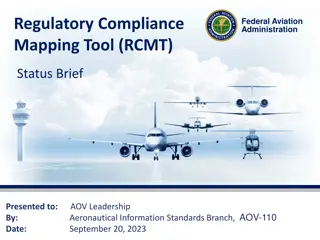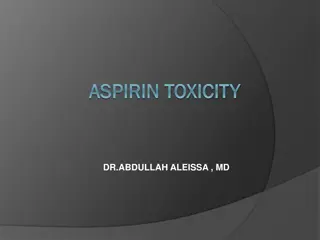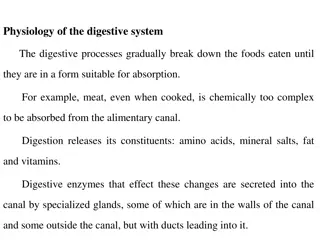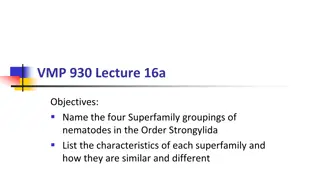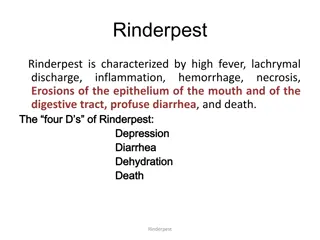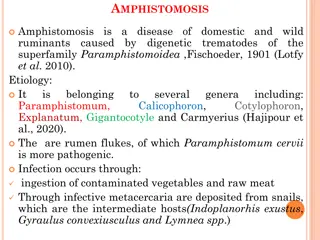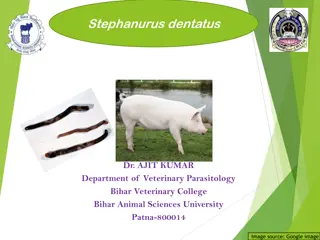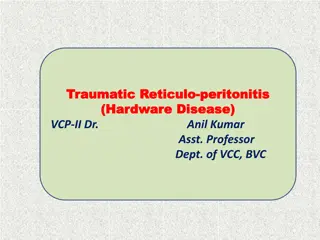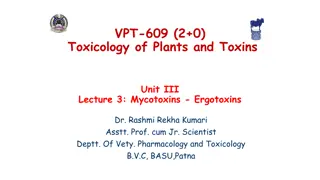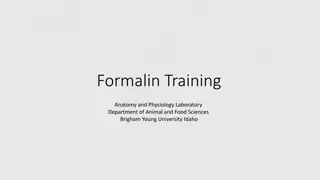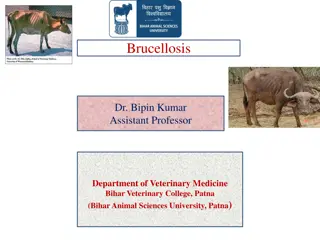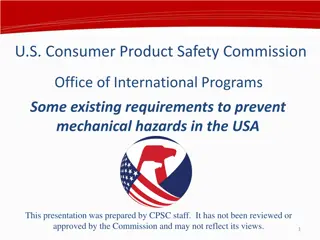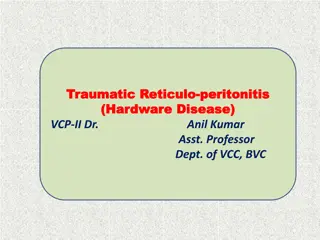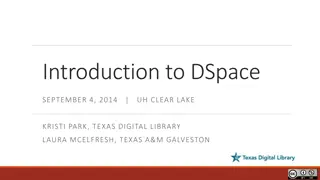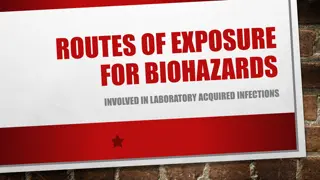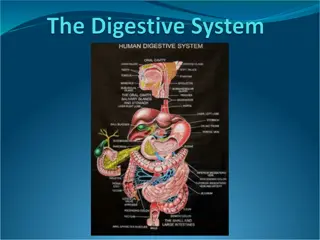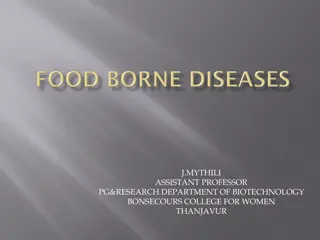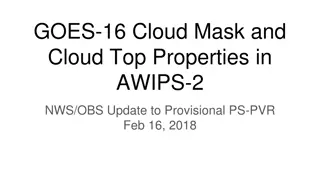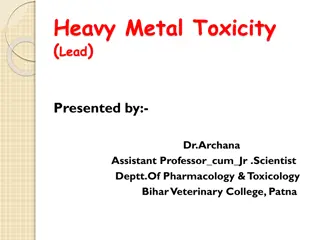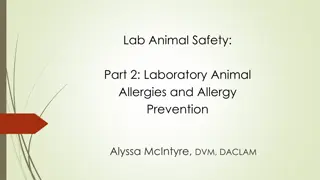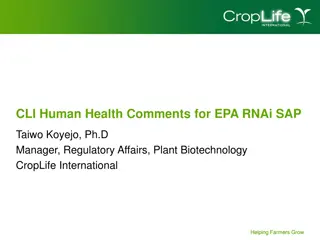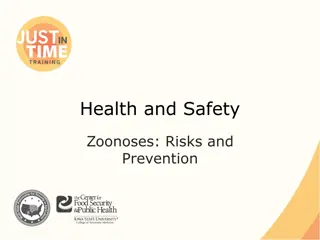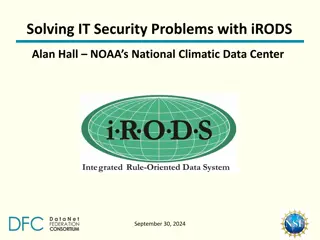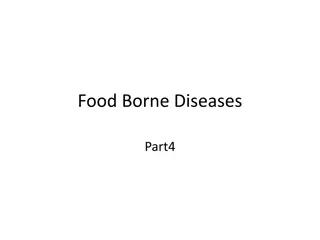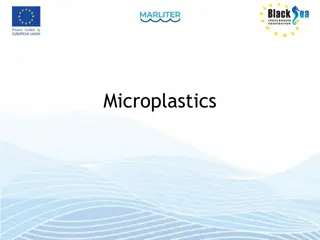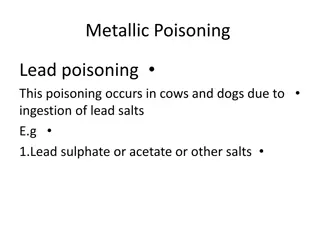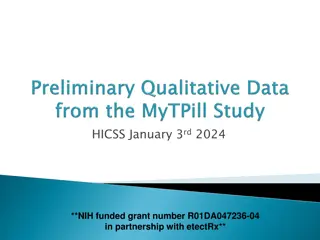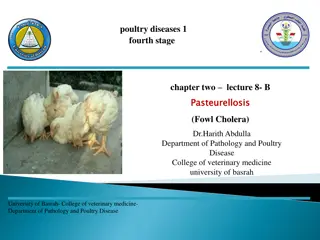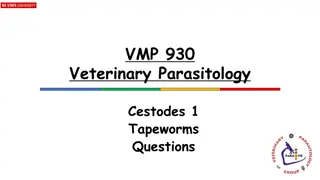Understanding the Digestive System Processes
The digestive system is responsible for the breakdown, absorption, and elimination of food. It involves processes such as ingestion, propulsion, mechanical and chemical digestion, absorption, and defecation. Starting from the mouth with salivary glands and oral cavity, it progresses through the esop
3 views • 38 slides
Regulatory Compliance Mapping Tool (RCMT) Status Update - September 20, 2023
The Regulatory Compliance Mapping Tool (RCMT) Federal Aviation Administration status update for September 20, 2023, highlights significant achievements, including software development progress, document ingestion, ontology updates, user interface testing, and security framework enhancements. The RCM
0 views • 7 slides
Understanding Aspirin Toxicity: Overview and Management
Aspirin toxicity, though decreasing in incidence, can still result in severe consequences such as metabolic acidosis, seizure, and even death. This condition is often underestimated due to lack of familiarity with its clinical presentation. Treatment focuses on maintaining salicylate in the ionized
0 views • 22 slides
Overview of Digestive System Physiology and Functions
The digestive system functions to break down food into absorbable forms through processes like ingestion, propulsion, digestion, absorption, and elimination. Specific organs and enzymes play key roles in these processes, ultimately providing nutrients for the synthesis of body constituents and energ
0 views • 13 slides
Overview of Superfamilies in Order Strongylida Nematodes
The Order Strongylida in nematodes encompasses four main superfamilies - Trichostrongyloidea, Strongyloidea, Ancylostomoidea, and Metastrongyloidea. Each superfamily is defined by distinct characteristics such as buccal cavity size and location within the host, as well as differences in life cycle a
1 views • 34 slides
Understanding Rinderpest: Symptoms, Transmission, and Host Range
Rinderpest is a viral disease characterized by high fever, lachrymal discharge, inflammation, erosions of the mouth, and diarrhea, leading to death. The disease affects cloven-hoofed animals, with cattle and water buffalo being most susceptible. Transmission occurs through aerosol vectors and ingest
0 views • 60 slides
Understanding Amphistomosis in Ruminants: Causes, Symptoms, and Diagnosis
Amphistomosis is a disease in ruminants caused by several types of rumen flukes. It leads to productivity losses, weight loss, fertility reduction, and other symptoms. Infection occurs through ingestion of contaminated vegetables and raw meat. The parasite affects the rumen and reticulum of sheep, g
0 views • 8 slides
Understanding Stephanurus Dentatus: Kidney Worm of Pigs
Stephanurus dentatus is a parasitic worm that infects pigs, with an intricate life cycle involving earthworms as transport hosts. Transmission occurs through ingestion of larvae or infected earthworms, leading to various pathological effects, including subcutaneous nodules, cirrhosis, and organ dama
0 views • 13 slides
Foot and Mouth Disease: Overview, Symptoms, and Sequelae
Foot and Mouth Disease, also known as Aphthous fever, is a highly contagious viral infection affecting cloven-hoofed animals. It is characterized by the formation of vesicles and erosions in the mouth, nose, teats, and feet. The disease can cause a fall in milk yield, high fever, loss of appetite, a
1 views • 8 slides
Understanding Traumatic Reticuloperitonitis in Cattle
Traumatic reticuloperitonitis, also known as hardware disease, is a serious condition in cattle caused by the ingestion of foreign objects. The perforation of the reticulum wall leads to peritonitis and potential complications affecting various body systems. Recognizing the clinical signs, such as s
0 views • 10 slides
Understanding Ergot Alkaloids: Toxicology of Plants and Toxins
Ergot alkaloids are toxins produced by parasitic fungi that invade cereal crops and grasses, leading to the formation of ergot. These toxins, including ergometrine and ergotamine, have various effects on the central nervous system, smooth muscles, and overall health. Ergotism, resulting from the ing
0 views • 14 slides
Formalin Safety Guidelines in Anatomy and Physiology Laboratory
Formalin, a mixture of formaldehyde and water, is used in laboratories to preserve tissues. OSHA regulates exposure levels due to health risks. Proper ventilation and personal protective equipment are crucial to control exposure. The laboratory employs engineering controls and monitoring for safety.
0 views • 16 slides
Understanding Brucellosis: A Zoonotic Disease Impacting Animals and Humans
Brucellosis, caused by the genus Brucella, is a zoonotic disease affecting animals like goats, sheep, cattle, and humans. It is primarily transmitted through contact with infected animals or ingestion of their products. The disease manifests in various forms like Mediterranean fever and can lead to
0 views • 13 slides
Preventing Mechanical Hazards in Consumer Products: U.S. Regulations
The U.S. Consumer Product Safety Commission (CPSC) enforces various requirements to prevent mechanical hazards in consumer products. These regulations cover toys, children's clothing, infant products, and more. Standards such as ASTM F963 outline specific safety measures for small parts, strangulati
1 views • 13 slides
Traumatic Reticuloperitonitis (Hardware Disease) in Cattle: Causes and Clinical Signs
Traumatic reticuloperitonitis, also known as Hardware Disease, is a common condition in cattle caused by the ingestion of foreign objects. This article discusses its etiology, pathogenesis, and clinical findings such as sudden onset of rumino-reticular atony and decreased milk production. Perforatio
0 views • 10 slides
Overview of DSpace and the Texas Digital Library
This presentation provides an introduction to DSpace and the Texas Digital Library, offering insights into topics such as DSpace basics, content ingestion workflows, metadata management, and the collaborative efforts within the Texas Digital Library consortium. Learn about the infrastructure, featur
0 views • 62 slides
European Deep Space Surveillance and Tracking Collaboration
EU Space Surveillance and Tracking program involves five European nations collaborating to assess and reduce risks to European spacecraft, provide early warnings for re-entries and space debris, and prevent space debris proliferation. Available deep space sensors, such as optical telescopes, are uti
1 views • 8 slides
Honey Bee Exposure to Pesticides: Routes and Impacts
Analysis by the U.S. Environmental Protection Agency outlines various exposure routes of honey bees to pesticides, including contact with contaminated sources like foliage and soil, ingestion of contaminated pollen and nectar, and inhalation of chemical droplets. Different application types and age
2 views • 13 slides
Laboratory-Acquired Infections: Routes of Exposure and Prevention Measures
The content discusses laboratory-acquired infections from 1930 to 2015 and highlights exposure routes such as facial mucous membranes, percutaneous, ingestion, inhalation, and non-traditional routes like eye and nasal cavity. It emphasizes the importance of biosafety practices, identifies GI pathoge
0 views • 21 slides
Understanding Cyanide: Sources, Exposure, and Risks
Cyanide is a toxic compound found in various forms such as gases, solids, and liquids that can be harmful to humans and animals. Sources of cyanide exposure include natural processes, industrial activities, plant sources, and combustion products like cigarette smoke. The extent of poisoning depends
0 views • 14 slides
Understanding the Human Digestive System: A Comprehensive Overview
The digestive system plays a vital role in breaking down food into nutrients for absorption. This process involves stages like ingestion, digestion, absorption, and egestion. Beginning with the mouth, food moves through the esophagus, stomach, and small intestine for digestion and absorption of nutr
0 views • 21 slides
Chi: A Scalable and Programmable Control Plane for Distributed Stream Processing
Distributed stream processing systems are increasingly crucial for various production use cases, such as real-time dashboards, machine learning, and interactive debugging. The challenges of handling large variability in production ingestion workloads and high-degree data skew in queries are addresse
1 views • 20 slides
Understanding Food-Borne Diseases: Causes, Symptoms, and Prevention
Food-borne diseases are caused by the ingestion of contaminated food containing microorganisms or chemicals. There are two types of food infections - contaminated food acting as a carrier of microorganisms and food serving as a culture medium for pathogens. Bacteria, viruses, and parasites are commo
0 views • 20 slides
GOES-16 Cloud Mask and Top Properties Update in AWIPS-2 NWS/OBS
GOES-16 provides Cloud Mask and Cloud Top Properties data through AWIPS-2, including information on cloud top height, pressure, temperature, and clear sky mask. This update covers the handling, display, and ingestion of these products by NWS, starting from June 2017. The data is transmitted via SBN
0 views • 8 slides
Understanding Lead Toxicity: Sources, Symptoms, and Treatment in Animals
Lead toxicity, or lead poisoning, can have serious health implications for animals, particularly in cases of ingestion through contaminated sources. This article discusses the sources, toxicokinetic processes, clinical signs, and treatment of lead toxicity in veterinary medicine, highlighting the im
0 views • 14 slides
Understanding Traumatic Reticuloperitonitis in Cattle
Traumatic reticuloperitonitis in cattle is a severe condition caused by the penetration of the reticulum by metallic foreign objects. The ingestion of these objects leads to acute local peritonitis, with symptoms like anorexia, decreased milk yield, and pain during movement. If left untreated, it ca
0 views • 16 slides
Understanding Laboratory Animal Allergies and Prevention
Laboratory animal allergies pose a significant occupational hazard, with around 2 million workers at risk. Exposure routes include inhalation, skin contact, and ingestion. Factors such as pre-existing allergies, intensity of exposure, and secondhand exposure influence the likelihood of developing al
0 views • 30 slides
Understanding IoT Integration with Microsoft Azure IoT Hub
Explore the world of IoT integration with Microsoft Azure IoT Hub, designed to connect devices to Azure with features like per-device authentication, high throughput data ingestion, and reliable command and control. Learn about communication scenarios, solution architecture, information exchange pat
0 views • 15 slides
Safety and Efficacy of RNA in Human Diet and Agricultural Crops
RNA is a common component of the human diet, with naturally occurring RNAi mechanisms in various organisms. While staple foods contain RNA, barriers in the human body limit systemic exposure, making oral ingestion ineffective for RNAi. Studies have shown minimal bioavailability and efficacy of dieta
0 views • 9 slides
Clinical Cases Review: Neurological, Toxicological, and Orthopedic Presentations
Explore a collection of intriguing clinical cases including neurological symptoms, toxic ingestion, loss of consciousness, and orthopedic injuries. From CT findings to treatment modalities, delve into differential diagnoses, imaging investigations, risk factors, complications, and management strateg
0 views • 13 slides
Understanding Zoonotic Diseases and Prevention Strategies
Zoonotic diseases pose a risk as they can be transmitted from animals to humans under natural conditions. Awareness of transmission routes is crucial. Direct contact, ingestion, aerosol, and indirect transmission through fomites or vectors are common means of spreading these diseases. Animals may no
0 views • 15 slides
Solving IT Security Problems with iRODS at NOAA's National Climatic Data Center
The NOAA DFC Interoperability initiative aims to deposit climate data records securely by utilizing iRODS data grids. The integration of iRODS systems between OOI and NCDC simplifies data ingestion, provided security requirements are met. The setup includes iRODS Secure Ingest in the DMZ landing zon
0 views • 6 slides
Understanding Clostridium Perfringens Intoxication: Causes and Characteristics
Clostridium perfringens intoxication is a foodborne illness caused by the ingestion of food contaminated with enterotoxigenic strains of C. perfringens, leading to the production of Clostridium perfringens enterotoxin (CPE). This article discusses the characteristics of CPE, the origins of the organ
2 views • 23 slides
Understanding Microplastics: Impact on Marine Ecosystems
Microplastics are tiny plastic particles less than 5mm in diameter that pollute marine environments. These particles, including nanoplastics, can have significant impacts on ecosystems and organisms, although research on their effects is ongoing. Microplastics are generated from various sources, bot
0 views • 14 slides
Understanding Metallic Poisoning in Animals: Lead and Mercury
Metallic poisoning, specifically lead and mercury poisoning in animals, can result from ingestion of lead salts or mercury compounds. Symptoms, effects on the body, absorption, excretion, and treatment methods for these toxicities are discussed in detail to enhance awareness and understanding of the
0 views • 40 slides
Understanding Enamel Pearls and Fluorosis: Dental Abnormalities Explained
Enamel pearls are small spherical projections on root surfaces that can lead to plaque retention and gum disease if left untreated. They are caused by abnormal enamel formation during tooth development. On the other hand, fluorosis is marked by enamel hypomineralization due to excessive fluoride ing
0 views • 10 slides
Advancing Medication Adherence Through Digital Health Solutions
Research initiatives like the NIH-funded trials involving WisePill ID-Cap, MyTPill technologies, and remote monitoring systems aim to enhance medication adherence among substance users. By comparing adherence devices, conducting controlled crossover studies, and utilizing innovative ingestible event
0 views • 21 slides
Innovative Earthquake Monitoring Application PDL2AQMS in Action
PDL2AQMS is a Python application designed for injecting QuakeML data into AQMS databases, supporting both Oracle and Postgres systems. Developed by a team including Ellen Yu, Mike Hagerty, and Aparna Bhaskaran, this tool enables comparison of earthquake solutions and automates association processes.
0 views • 13 slides
Understanding Pasteurellosis (Fowl Cholera) in Poultry: Causes, Symptoms, and Management
Pasteurellosis, also known as Fowl Cholera, is an acute septicemic disease affecting domestic fowl and wild birds caused by Pasteurella multocida. This disease is characterized by high morbidity and mortality rates, primarily impacting chickens, turkeys, and ducks. The disease spreads through health
0 views • 10 slides
Understanding Tapeworm Infections in Veterinary Parasitology
Explore key concerns related to different tapeworm infections such as Taenia pisiformis, Taenia taeniaformis, Taenia saginata, Taenia solium, and Echinococcus. Learn about companion animal, economic, and human health concerns associated with these infections. Discover how humans can become infected
0 views • 8 slides

